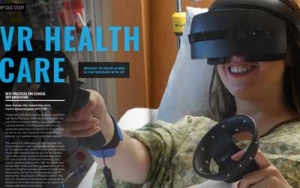VR Health Care Best Practices (AIMed)
Blog by Howard Rose
AIMed Magazine vol 3: VR Health Care p 62-65. Download
- Diane Gromala, PhD, Canada Research Chair in Computational Technologies for Transforming Pain, and Director of the Chronic Pain Research Institute and Pain Studies Lab at Simon Fraser University
- Frances Ayalasomayajula, MPH, PMP, Worldwide Lead for Population Health and Patient Engagement at HP
- Howard Rose, M.Ed, CEO and co-founder of Firsthand Technology
We came together to produce a series of recommended best practices for the Clinical Implementation of VR. Starting from first principles of “First do no harm”, we lay out a framework for those who are considering the adoption of VR in their clinical practice, or considering creating VR therapy applications or technology
[su_divider divider_color=”#ecebeb” link_color=”#ffffff”]
The evidence is clear that VR can make us healthier, smarter, and even happier. VR technology is now available to more humans on this planet than ever, but still only a small fraction have even tried it once, and the percentage of people with enough access, experience, and knowledge to differentiate between a good VR experience and a bad one is vanishingly small.
Good VR can transform us in profound ways, and it should make us feel good, not sick. Bad VR can be terrible in more ways than I can list, and it will make us sick. The success of VR to deliver big benefits, like innovate health care, depends on developers getting it right, and more sophistication from health care adopters to be able to pick out the wheat from the chaff. All VR is not created equal.
To put a point on this, even accounting for personal taste, nearly all of us have enough experience and sophistication to describe what differentiates a good movie from a bad one. Virtual worlds are way more complex than movies, with lots of subtle effects from the technology, the experience design, and countless elements of human factors. Getting VR right takes a lot of work.
The potential rewards for us getting VR right are big. Decades of research shows VR can profoundly improve the way we treat pain, do therapy, and treat mental illness. The potential keeps growing as we uncover more underlying mechanisms of action and new health applications for VR.
VR technology is steamrolling ahead, getting better, smaller, cheaper, faster. Don’t pay too much attention to short term measures like last quarter’s product announcements or sales figures. Honestly, I was skeptical myself for a long time about VR adoption, but the signs are obvious and I’m convinced VR is moving close to the tipping point of adoption especially in health and enterprise applications. In 10 years VR (and its cousin AR) will be ubiquitous, no question.
So the time is now to lay the groundwork for that future by aligning our sights on the aspects of VR with the greatest value for health and wellness. We started chipping away at this by addressing best practices in the areas of highest value for health practitioners and developers:
- Do no harm
- Use the best VR system you can
- Clinical protocols
- Patient preparation
- Clinical preparation
My co-authors and I are busy elaborating on each of these topics, and will be expanding into a few more key areas for consideration. Our goal here is not to own this topic for ourselves, but to instigate a broader dialog among all the stake holders. Please share your thoughts with us and with your colleagues. Let’s work together to make sure VR can achieve the promising future that so many of us envision.
– Howard
Special thanks to my awesome co-authors, Diane and Fran. I appreciate and learn from you so much.

